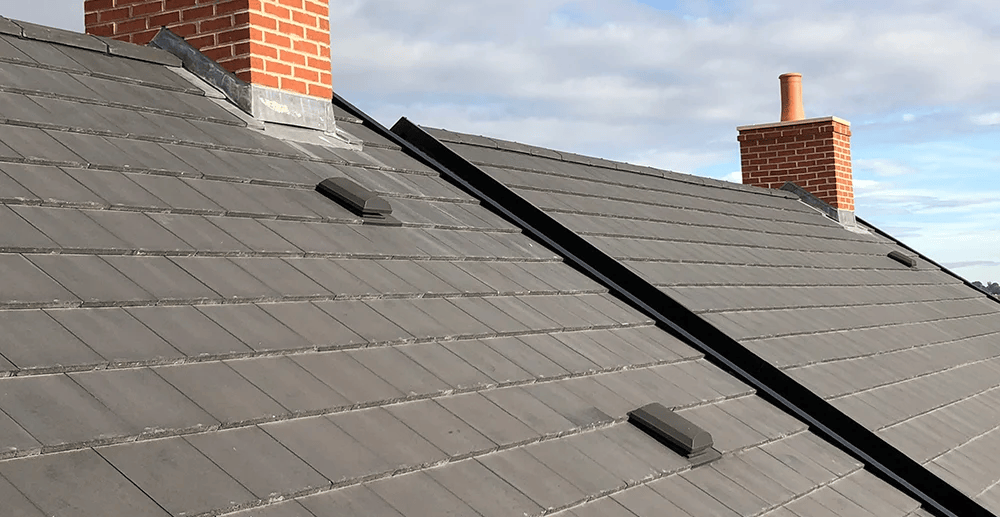A significant challenge when working on the roof of any existing, occupied building is protecting the people inside the building without the full roof system in place. That challenge is multiplied when the building in question is large and work has to be carried out in sections over a longer period of time.
At Hatchemeadow apartments in Northumberland, a key performance characteristic of Proctor Air that helped to address these challenges was its water holdout. That, combined with its vapour and air permeability, offered long-term peace of mind for the building owners, as well as apartment residents.
Multiple challenges presented on a single building Located close to the town of Ashington in Northumberland, Hatchmeadow apartments and bungalows is an age-exclusive development operated by the housing association, Bernicia.
The T-shaped apartment building features a 2500m2 pitched roof, including several gables and valleys. Unfortunately, problems with the existing roof specification were causing some residents to experience leaks during periods of poor weather. To address the issues once and for all, Bernicia tasked Wensley Roofing – part of the Northern Bear family of companies – with stripping back the existing roof and
installing a new system.
The roof included an area of solar PV panels, so the new roofing system had to be capable of providing weathertightness and condensation control in several different circumstances across the single building – all while residents remained in occupancy during the work. Using Proctor Air as part of a ‘belt and braces’ solution James Roy, Senior Quantity Surveyor at Wensley Roofing, describes the replacement roof system as a “belt and braces” approach.
“The specification used Proctor Air over the rafters, followed by counter battens, tile battens, and a new pantile finish,” he explained. “We even used butyl tape over the nail holes to provide a complete seal against rainwater.”
At the time of writing, Wensley Roofing are about halfway through the reroofing work. “Some of the residents were having to use buckets to catch leaking water,” said James. “Since installing this new system the leaks have now stopped, and there has been some bad weather.”
How has Proctor Air helped the reroofing process?
The attention to detail required to deliver the thorough specification, coupled with the size of the Hatchmeadow apartments roof, has naturally restricted the pace at which the work can be delivered. As a premium roofing membrane, Proctor Air has helped to alleviate any concerns about leaving the
underlay exposed for short periods of time. “The belt and braces approach has made labour a challenge on this project,” said James. “But with the Proctor Air membrane in place, we’ve been
comfortable leaving it exposed for a couple of days if necessary, knowing that residents in the apartments below are still protected.” This reassurance is possible because Proctor Air is rated W1 under EN 13859-1, with over 1m Head of Water, and has hydrophobic additive in all three of its layers. Its water resistance meets the guidance of NFRC’s Technical Bulletin 6. Additionally, the membrane can be left exposed to UV for up to three months.
Proctor Air allows the underlay to be used on roofs featuring solar PV, as long as a ventilated batten space is provided. This is in addition to tightly-jointed slates, tiles and metal sheet, all of which would also normally be considered vapour impermeable.
Because the Hatchmeadow apartments specification featured a counterbatten layer, Proctor Air could be used with confidence across the entire roof, including under the existing area of PV panels.
What other performance does Proctor Air deliver for the apartments?
As a roofing underlay, Proctor Air’s key function is as a low-resistance (LR), vapour-permeable membrane. With an Sd value of 0.02m and a vapour resistance of 0.1MNs/g, Proctor Air is one of the highest performing vapour-permeable membranes on the market.
As well as vapour permeability, Proctor Air provides air permeability. This means no ventilation measures are required in cold roof spaces, since the membrane permits the passage of both air and moisture vapour through the roof construction.
At Hatchmeadow apartments, the reroofing offered the opportunity to top up the insulation in the roof and provide extra thermal comfort. However, with all the work carried out externally, it wasn’t possible to also check on the continuity and integrity of any vapour control layer (VCL) below the insulation.
Using Proctor Air meant this was not an issue. In new-build scenarios, Proctor Air requires no VCL in the ceiling, which also does not need to be wellsealed, so the existing ceiling construction did not matter to the effectiveness of the new underlay. Similarly, Proctor Air’s air permeability provides a more uniform flow of air in the roof space than normal vents. Regardless of the effectiveness of existing ventilation measures at Hatchmeadow apartments, using Proctor Air meant the roof now benefits from more reliable ventilation and condensation control, which will prolong the life of the new specification.
Combined with stopping the problem of leaks in bad weather, Proctor Air has helped to provide a complete solution for Bernicia. As James Roy concluded: “The overarching theme with this project is long-term peace of mind – for the client and for the apartment residents.”
About A. Proctor Group
As a 4th generation family business with a history of technical innovation and promoting good practice, A. Proctor Group has a reputation for bringing new ideas to the market. Proctor Air is A. Proctor Group’s roofing membrane designed for the future. It simplifies pitched roof constructions, being both air permeable and vapour permeable. And its water holdout performance and wind uplift resistance ensure it is able to cope with more frequent extreme weather driven by climate change.
Find out more at https://proctorgroup.com/products/proctor-air




